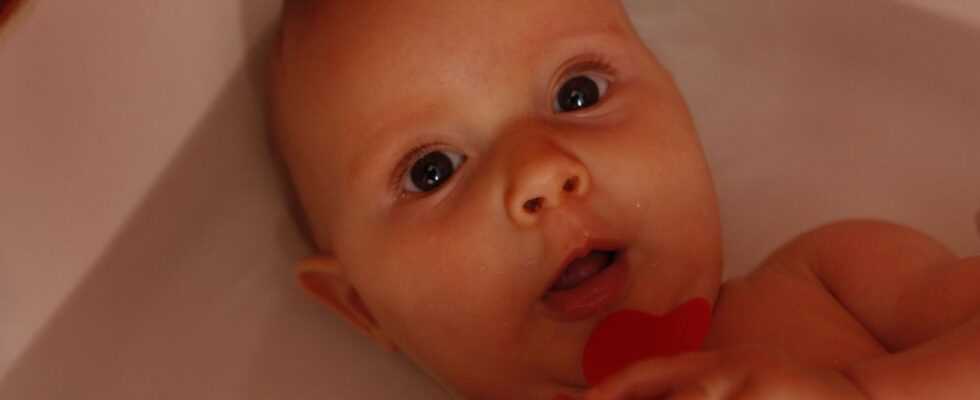Water, and a fortiori the bath, is often seen as a potential danger for children … (in part) wrongly! It is a great element for developing baby's motor skills, as long as you leave him free to move around – while watching him -. This is the concept of free swimming, which Michèle Forestier, a physiotherapist specializing in early childhood, explains in detail.
Transat? Bath ring? Plastic baby tub? With or without a stand? Choosing the right equipment for baby's bath is a bit of a puzzle when making the birth list. And yet, going for the bare minimum seems to be best for baby. This is what Michèle Forestier, physiotherapist, and free swim enthusiast advocates, a method whose benefits she has been touting for over 40 years!
What is open swim?
Free bathing is a method that consists of lying baby on his back in a water base (approximately 4 to 5 cm) and leaving him free to move during the bath, while keeping an eye on him at all times. “Open bathing can be practiced from 2 months old. The idea is not to hold the child under the head and to let him move freely in the water. As the child is on his back and the water is reaching his ears, there is no risk of drowning since his airways are completely clear”, Explains Michèle Forestier. To reassure the child, the parent can put their hand on their stomach.
Free swimming in practice
The watchword is "no hindrance to baby's movements or artifice”, Insists the physiotherapist. Concretely, for the free bath, you only need a classic bathtub. If you don't have one at home and have a shower tray or walk-in shower, "use a small plastic pool or a large plastic storage drawer found in decoration stores”, Advises the specialist. The idea is for the child to have enough space to lie down in the water.
Fill your bathtub, your shower tray (closed with a stopper) or another container of your choice with a bottom of hot water (between 35 and 37 ° C), about 4/5 cm. As a guideline, the water should come to about the level of baby's ears, not higher. Lay baby on his back in the water and let him move freely for a few moments, "without ever taking your eyes off him”, Recalls Michèle Forestier. If you are uncomfortable not having direct contact with the baby or holding his head, you can put a hand on his tummy to reassure him. Also, for parents who are worried about the child slipping, it is possible to place a towel under their back.
After allowing it to bubble freely for a few moments, soap your little one directly in water and then rinse it by gently passing the jet of the shower over its body.
What are the advantages of free swimming?
Open bathing has many advantages for both children and parents:
- Free to move around, the child can discover the water element without hindrance because it is not in a confined space and it is not held by an adult. “During the first free baths, the baby performs involuntary movements, then over the baths, he will feel more and more comfortable in the water and will engage his motor skills. The baby will try to roll up his legs, pedal with his legs, etc.”, Details the physiotherapist.
- The person who gives the bath gets tired less because her hands are free and she doesn't have to bend down, only watch baby.
- You save water and money because you don't have to buy unnecessary items such as a swim ring or a pre-formed baby tub. “The problem with the baby bath is that around 3/4 months the baby no longer fits fully lying down so you have to sit down, which considerably limits his movements. As for the swim ring, it allows the baby to sit still but at no time does the child learn to roll over in the water without help.”, Warns the specialist.
- The baby learns on his own to change position and get out of awkward situations / positions. “A baby can roll over on his stomach between 5 and 7 months. Thanks to the free bath that he will have experienced from an early age, he will be able to switch from the position on his back to the position on his stomach in the water, without putting himself in danger, because he will have the reflex to bend the arms so as not to end up with the nose and mouth in the water, and can even then move to a sitting position without the help of an adult”.
What are the disadvantages of free swimming?
The main disadvantage of open bathing is that the baby can feel cold because the water does not cover the whole body. This is why you should not hesitate to regularly pass hot water on the non-submerged areas of the body to maintain his body temperature. The room must also be well heated, with a temperature between 22 and 25 ° C, and without drafts.
Free bathing therefore allows babies to develop their motor skills and autonomy, but also to discover the aquatic universe in complete freedom. This practice, which goes against all the unnecessary equipment that we are offered today for baby bathing, falls within the framework of free motor skills: letting the child learn to move at his own pace by letting him great freedom of movement!
Source: thanks to Michèle Forestier, physiotherapist specializing in early childhood, author of “From birth to first steps: supporting the child in his motor discoveries”, published by Erès.
To read also on aufeminin
What is free motor skills?
Our step-by-step advice for bathing your baby
Baby hygiene explained step by step
How to apply the Montessori method at home?
